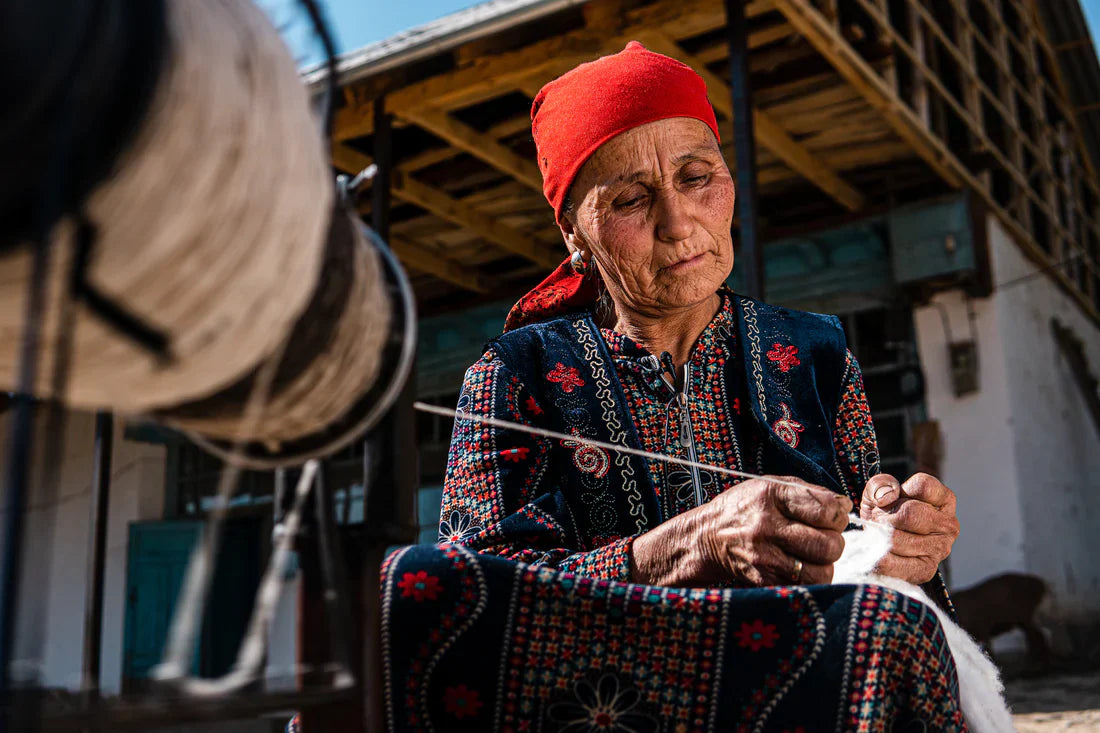A heated in-house debate has been underway for as long as Wildling Shoes has been in existence: cotton, yes or no? On the one hand, cotton - particularly conventional cotton - is criticized for its negative impact, such as the excessive amounts of water it consumes and the working conditions in downstream production processes. But on the other hand, cotton boasts some ideal qualities, especially for footwear: High-quality processed cotton fabrics are extremely durable and resistant to wear.
We definitely don’t want to replace cotton with synthetic fibers (which are fibers made from fossil raw materials, such as polyester). And other natural fabrics – like hemp and linen – work very well as shoe materials, but they still pose a few manufacturing challenges that need to be resolved.
That’s why cotton offers a host of advantages. It’s a natural material, it has a long service life, and with proper processing, it’s highly durable. For now, we neither want to nor are able to completely replace cotton.
Let’s make the best of it.

Tengri has an upper made from 100% single-source cotton. Image: Camila Jara barra.
Regenerative approach No. 1: Create lasting partnerships and transparent supply chains with single-source cotton.
When we procure a material exclusively from one supplier, we can refer to it as a single-source material. While this kind of procurement gives us less flexibility, it also affords us the benefits of trust-based cooperation.
For many years, we’ve been working closely with our supplier Elmer & Zweifel. We have been using their fabrics to make our shoe linings for a very long time. As a sort of happy coincidence, a random conversation brought up the possibility of obtaining material that Wildling Shoes could use for uppers, too.
Elmer & Zweifel operates and acts according to its own self-imposed values. This German textile company does not purchase their raw materials on the world market. They maintain a transparent supply chain that extends all the way to cultivation, and they are committed to organic farming practices and local social projects. Their Cotonea brand exemplifies this commitment.
“Since that was established, we have controlled the entire production chain – cultivation, spinning, weaving, finishing, tailoring, and sale – from the cotton field to the store shelves. Cotonea and the farmers agree together on fixed prices for the required purchase quantity that include a premium for organic products, while never falling below a specific minimum price – even when global market prices are lower. A fairtrade premium paid to the cooperative is also added.”
Source: Cotonea
For our summer 2022 collection, we have again sourced many cotton fibers from Cotonea, in support of their organic cotton projects.
Going forward, our goal is to use cotton from Cotonea projects exclusively wherever virgin cotton (raw ginned cotton with no recycled content) is needed.That also means that we have asked all of our suppliers that process cotton for us to switch to Cotonea. Using these yarns, we then enter into a joint fabric development process, which means that the planning lead times are quite lengthy.

The saker features an upper made from 100% recycled cotton. Image: @nata.horinkova
Regenerative approach No. 2: We draw from that which is plentiful and readily available and utilize recycled cotton.
One thing that is inherently positive about recycled cotton: Right off the bat it’s clear that recycled material is more resource-efficient than virgin material since it doesn’t require growing any new raw material. So doesn’t that mean it would be a great idea to make all Wildling models from recycled material?
Stotz (Stotz & Co. AG), our supplier for 100% recycled cotton, uses pre-consumer waste from industrial waste, from spinning mills and weaving mills, for instance. These waste materials are all still untreated and undyed. Apart from that, another great thing is that there really is no virgin content added into the mix.
However, what pre-consumer also means in this context is that the cotton is not derived from used clothing, so we can’t provide a solution to that global problem at the moment either.
Of course, new yarns from used clothing are already available, but they are never made from 100% cotton, because it’s impossible to completely sort by type. What’s more, synthetic fibers are often blended in to improve stability.

Image: Textile waste. Made available by Annabelle Hutter (Saentis Ltd).
To extract individual fibers from the industrial waste (in other words, the finished woven cotton fabrics) so that they can be spun again, these fabrics have to be torn. That means that the fiber length of the recycled material is very short. Processing these short fibers into a sturdy yarn involves twisting four individual strands together, a method known as four-ply twisting. Naturally, this makes the yarn very thick, limiting its usefulness and eliminating our ability to use it as a substitute for any other cotton fabric. It wouldn’t be a suitable material to make the lining for Wildling shoes, for instance.
But this yarn also boasts some seriously great qualities, which we make the most of. When woven into a tight weave, it makes for an extremely dense and rugged fabric that is well suited for rainy days.
Regenerative approach No. 3: We are on the lookout.
With the regular GOTS-certified (Global Organic Textile Standard) organic cotton from the world market – which we are also still using today – we usually can’t clearly trace it back to its source. That’s why we’re on the lookout for other cotton suppliers that have a transparent and traceable supply chain, with whom we can work together to transform the existing structures, just like we’re doing with our partner Elmer & Zweifel.
We also continue to research, test, and improve cotton alternatives. In terms of material development, we are looking at ways to use linen and hemp, and working on projects that encourage cultivation in Europe. We ourselves are genuinely curious to see which materials will ultimately “materialize” on our path toward an ever more regenerative product.
Cover image: Spinning cotton by hand (Kyrgyzstan). Subankulov Sanzhar


